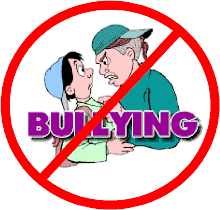1) How do bullies select their targets?
The bully selects their target using the following criteria:
- bullies are predatory and opportunistic - you just happen to be in the wrong place at the wrong time; this is always the main reason - investigation will reveal a string of predecessors, and you will have a string of successors
- being good at your job, often excelling
- being popular with people (colleagues, customers, clients, pupils, parents, patients, etc)
- more than anything else, the bully fears exposure of his/her inadequacy and incompetence; your presence, popularity and competence unknowingly and unwittingly fuel that fear
- being the expert and the person to whom others come for advice, either personal or professional (ie you get more attention than the bully)
- having a well-defined set of values which you are unwilling to compromise
- having a strong sense of integrity (bullies despise integrity, for they have none, and seem compelled to destroy anyone who has integrity)
- having at least one vulnerability that can be exploited
- being too old or too expensive (usually both)
- refusing to join an established clique
- showing independence of thought or deed
- refusing to become a corporate clone and drone
Jealousy (of relationships and perceived exclusion therefrom) and envy (of talents, abilities, circumstances or possessions) are strong motivators of bullying.
2) Events that trigger bullying
Bullying starts after one of these events:
- the previous target leaves
- there's a reorganization
- a new manager is appointed
- your performance unwittingly highlights, draws attention to, exposes or invites unfavorable comparison with the bully's lack of performance (the harder you work to address the bully's claims of under-performance, the more insecure and unstable the bully becomes)
- you may have unwittingly become the focus of attention whereas before the bully was the center of attention (this often occurs with female bullies) - most bullies are emotionally immature and thus crave attention
- obvious displays of affection, respect or trust from co-workers
- refusing to obey an order which violates rules, regulations, procedures, or is illegal
- standing up for a colleague who is being bullied - this ensures you will be next; sometimes the bully drops their current target and turns their attention to you immediately
- blowing the whistle on incompetence, malpractice, fraud, illegality, breaches of procedure, breaches of health & safety regulations etc
- undertaking trade union duties
- suffering illness or injury, whether work related or not
- challenging the status qua, especially unwittingly
- gaining recognition for your achievements, eg winning an award or being publicly recognized
- gaining promotion
3) Personal qualities that bullies find irresistible
Targets of bullying usually have these qualities:
- popularity (this stimulates jealousy in the less-than-popular bully)
- competence (this stimulates envy in the less-than-competent bully)
- intelligence and intellect
- honesty and integrity (which bullies despise)
- you're trustworthy, trusting, conscientious, loyal and dependable
- a well-developed integrity which you're unwilling to compromise
- you're always willing to go that extra mile and expect others to do the same
- successful, tenacious, determined, courageous, having fortitude
- a sense of humor, including displays of kindheartedness
- imaginative, creative, innovative
- idealistic, optimistic, always working for improvement and betterment of self, family, the employer, and the world
- ability to master new skills
- ability to think long term and to see the bigger picture
- sensitivity (this is a constellation of values to be cherished including empathy, concern for others, respect, tolerance etc)
- slow to anger
- helpful, always willing to share knowledge and experience
- giving and selfless
- difficulty saying no
- diligent, industrious
- tolerant
- strong sense of honor
- irrepressible, wanting to tackle and correct injustice wherever you see it
- an inability to value oneself whilst attributing greater importance and validity to other people's opinions of oneself (eg through tests, exams, appraisals, manager's feedback, etc)
- low propensity to violence (ie you prefer to resolve conflict through dialogue rather than through violence or legal action)
- a strong forgiving streak (which the bully exploits and manipulates to dissuade you from taking grievance and legal action)
- a desire to always think well of others
- being incorruptible, having high moral standards which you are unwilling to compromise
- being unwilling to lower standards
- a strong well-defined set of values which you are unwilling to compromise or abandon
- high expectations of those in authority and a dislike of incompetent people in positions of power who abuse power
- a tendency to self-deprecation, indecisiveness, deference and approval seeking
- low assertiveness
- a need to feel valued
- quick to apologize when accused, even if not guilty (this is a useful technique for defusing an aggressive customer or potential road rage incident)
- perfectionism
- higher-than-average levels of dependency, naivety and guilt
- a strong sense of fair play and a desire to always be reasonable
- high coping skills under stress, especially when the injury to health becomes apparent
- a tendency to internalize anger rather than express it
The typical sequence of events is:
- the target is selected using the criteria above, then bullied for months, perhaps years
- eventually, the target asserts their right not to be bullied, perhaps by filing a complaint with personnel
- personnel interview the bully, who uses their Jekyll and Hyde nature, compulsive lying, and charm to tell the opposite story (charm has a motive - deception)
- it's one word against another with no witnesses and no evidence, so personnel take the word of the senior employee - serial bullies excel at deception and evasion of accountability
- the personnel department are hoodwinked by the bully into getting rid of the target - serial bullies are adept at encouraging conflict between people who might otherwise pool negative information about them
- once the target is gone, there's a period of between 2-14 days, then a new target is selected and the process starts again (bullying is an obsessive compulsive behavior and serial bullies seem unable to survive without a target on to whom they can project their inadequacy and incompetence whilst blaming them for the bully's own failings)
- even if the employer realities that they might have sided with the wrong person in the past, they are unlikely to admit that because to do so may incur liability
- if legal action is taken, employers go to increasingly greater lengths to keep targets quiet, usually by offering a small out-of-court settlement with a comprehensive gagging clause
- employers are often more frightened of the bully than the target and will go to enormous lengths to avoid having to deal with bully (promotion for the bully is the most common outcome)

















